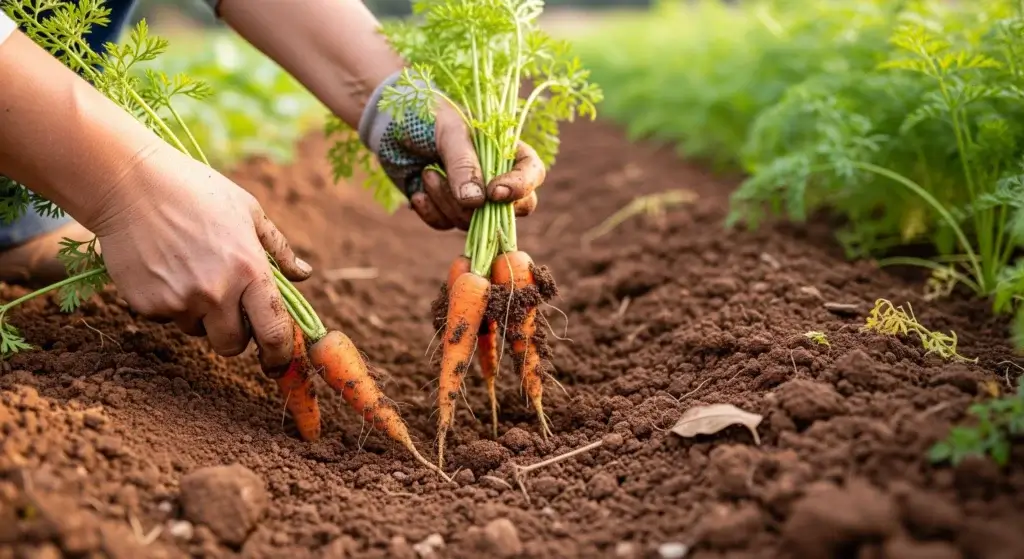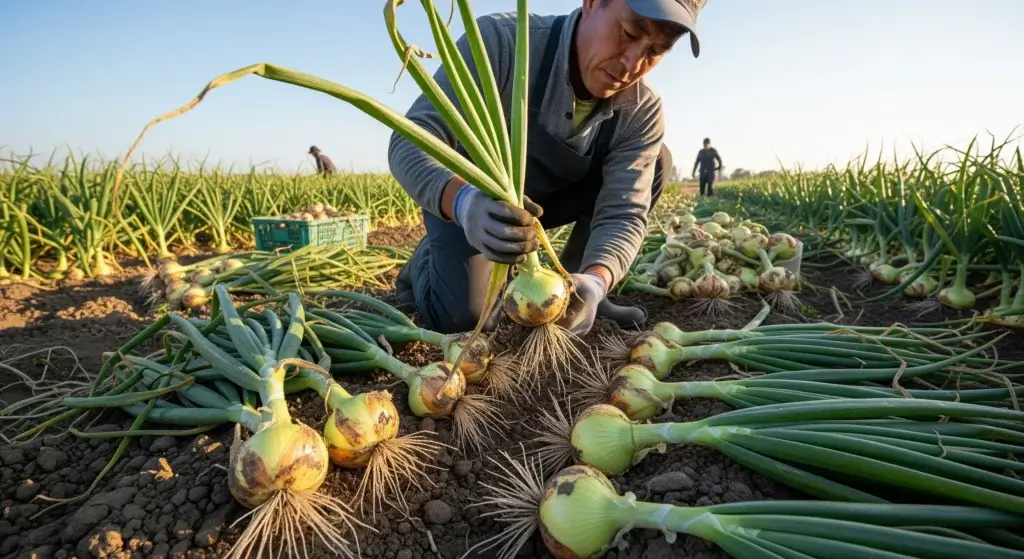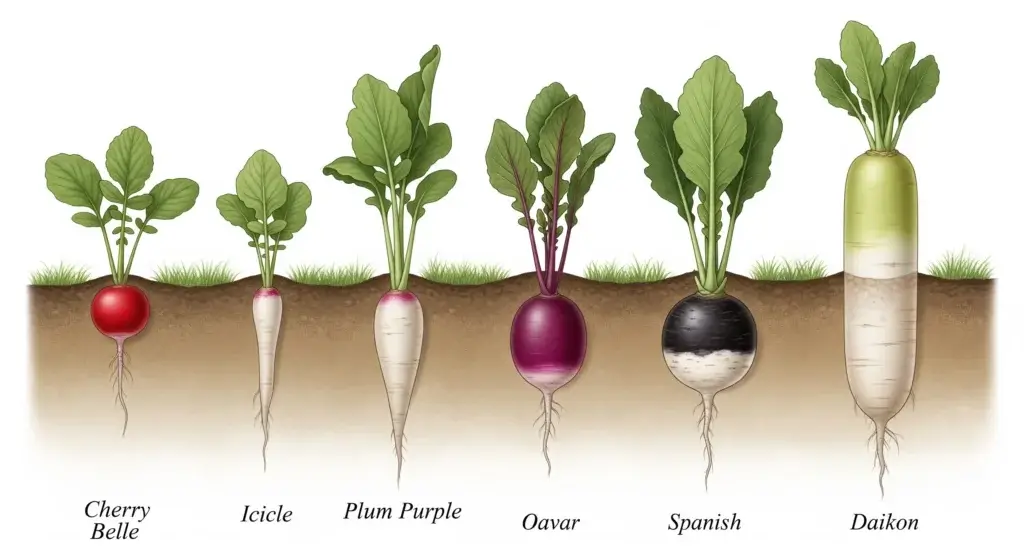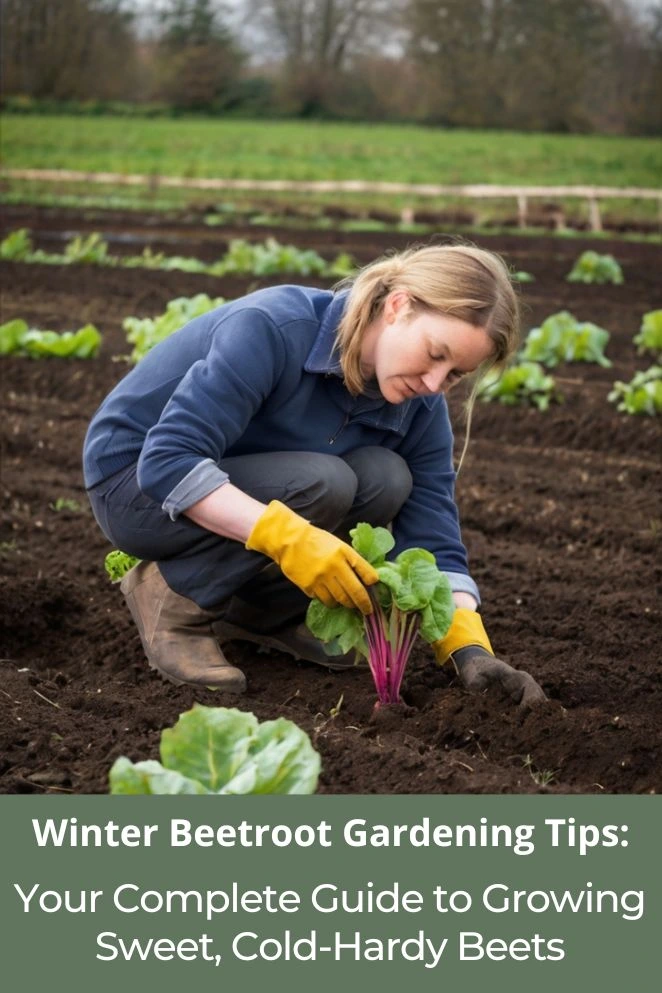
Winter doesn’t mean your garden has to take a nap.
Beets actually like the cold—they get sweeter and taste better.
While most folks pack up after the first frost, smart gardeners keep planting.
Whether you’re a pro or just getting started, this guide shows you how to grow fresh, tasty beets all winter long.
Why Choose Winter Beetroot Growing?
Most veggies tap out when it gets cold. Beets? They lean in.
Winter beet growing isn’t just possible—it’s smart. Here’s why:
They taste better in the cold
Beets turn starch into sugar when it gets chilly. It’s their way of staying cozy.
For you, it means sweeter roots with better flavor than anything you’d get in summer.
These winter beets are next-level for roasting, pickling, or tossing in salads.
Extended harvest period
Winter beet varieties grow slow and steady.
That’s good news—you don’t have to pull them all at once. Harvest as needed and skip overpriced store produce when the shelves look sad.
Small space? No problem
Beets don’t sprawl. You can grow them in containers, raised beds, or even a balcony box.
They’re compact and tidy—basically the apartment-friendly veggie.
Nutritional benefits
Beets are packed with good stuff: folate, potassium, nitrates, and betalains (aka the reason they’re so red and healthy).
Growing them in winter keeps your diet on point when fresh veggies are harder to find.
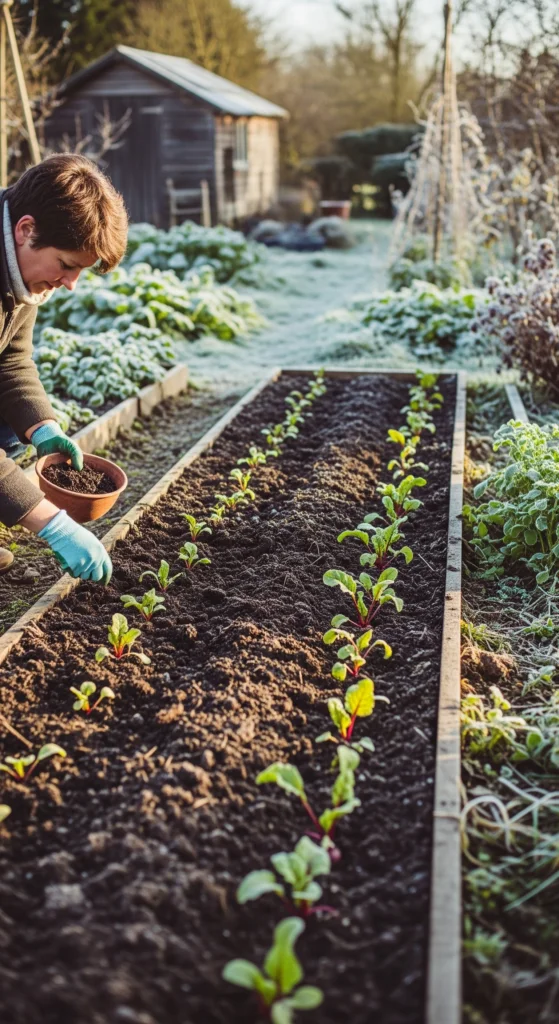
Best Winter Beetroot Varieties for Cold Weather Success
Not all beets are built for winter.
Some tap out at the first frost. Others? They dig in and thrive.
If you want solid results in cold weather, picking the right variety makes all the difference.
Here are your top beet buddies for winter growing:
Detroit dark red
This one’s the GOAT of winter beets.
Grows round, deep red roots that hold up in the cold—down to 15°F (-9°C) with barely any help.
Stores like a champ, tastes even better. If you’re new to winter beets, start here.
Cheltenham green top
Old-school, tough as nails.
These beets grow long instead of round, which makes them easier to yank out of frozen ground.
Plus, the green-tinged tops look cool, and the roots get extra flavorful when it’s cold. Great for winter storage.
Lutz green leaf
This variety was made for winter. The roots get big—like, really big—but stay sweet and tender.
Great if you want fewer plants that produce more food.
Also stores for months without turning into sad, wrinkly beet mummies.
Chioggia
These Italian beets are the flashy ones—pink-and-white candy stripes inside.
Not quite as frost-hardy as the others, but still fine with a little protection.
Use them when you want your winter salads to look fancy without trying too hard.
Egyptian flat
Short on space or growing in containers? This one’s your jam.
Grows flat, disc-shaped roots that work great in shallow soil.
Fast grower, handles the cold, and perfect for planting in waves through fall and early winter
Soil Preparation and Winter Growing Conditions
Winter growing is a bit of a game—cold temps, wet soil, slow growth.
But if you set up your soil right, your beets will cruise through the season like pros.
Here’s how to get your dirt in shape:
Warm that soil up
Beet seeds want the soil at least 50°F (10°C) to sprout.
In winter, that’s a stretch—so help it out.
Use black plastic, row covers, or a cold frame to trap heat. It’s like giving your beets a cozy blanket while they grow.
Keep it draining, not drowning
Winter means rain, snow, and slushy messes.
Beets hate wet feet. If your soil holds water, your roots could rot.
Use raised beds or add compost and sand to improve drainage. Think “moist,” not “mud pit.”
pH check
Aim for a pH between 6.0 and 7.5. Cold weather can mess with soil chemistry, so test in fall.
Too acidic? Add lime. Too alkaline? A little sulfur helps.
No guessing—get that test.
Feed the soil, not just the plant
Mix in compost or rotted manure before planting.
It loosens the soil and gives your beets a slow-release food source.
Skip fresh manure unless you want your beets looking like hairy monsters.
Don’t forget the phosphorus
Roots need extra love in winter, and phosphorus helps.
Mix in stuff like bone meal, rock phosphate, or bat guano when prepping the bed.
It helps roots grow deep and strong, even when the plant’s metabolism slows down.
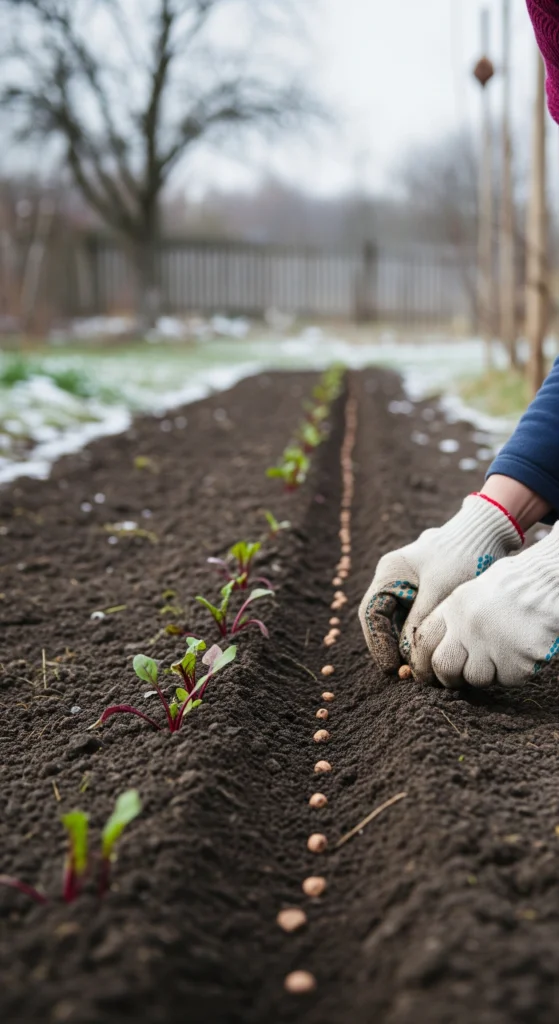
Planting Techniques for Winter Success
Cold weather slows everything down—including your beets.
So, you’ve got to tweak your planting game if you want a solid winter harvest. Here’s how to do it right:
Soak your seeds first
Before planting, soak beet seeds in warm water for 12–24 hours.
This softens their tough outer coat and helps them sprout faster in chilly soil.
Basically, it’s like giving your seeds a spa day before they hit the dirt.
Planting depth + spacing
- Drop seeds about ½ to 1 inch deep—go a little shallower than you would in summer.
- Space them 2–3 inches apart.
- Rows should be 12–18 inches apart.
Want baby beets? Plant closer. Want big, beefy roots? Give them room.
Cover them up
Right after planting, throw on a row cover or use a low tunnel.
These boost the soil temp by 5–15°F. T
hat’s enough to get your seeds moving instead of just sitting there wondering what happened to summer.
Direct seed or transplant
Normally, you’d just plant beets straight in the ground.
But in winter? Consider starting them indoors and transplanting them outside once they’ve got a few leaves.
It’s like giving them a head start on the cold.
Mulch like a pro
Once your beet babies hit 2–3 inches tall, mulch around them with straw, leaves, or grass clippings.
Mulch keeps the soil warm, holds moisture, and stops weeds from crashing the party.
Winter Care and Maintenance Strategies
Winter beets don’t need babysitting, but they do need a little attention.
Cold weather slows things down, but it also brings new challenges.
Here’s how to keep your beets happy all season.
Water, but chill about it
Beets still need moisture in winter—but not as often. Water deeply, just not every day.
Let the soil dry out a bit between waterings. Skip overhead watering when it’s freezing—unless you want beetcicles.
Watch out for hard freezes
Beets handle light frosts like champs, but serious cold can mess them up.
When temps dip hard, toss on frost blankets, row covers, or drop them into a cold frame. It’s like a winter jacket for your plants.
Weed patrol
Weeds still show up in winter—they’re just slower. Don’t let them steal nutrients.
Pull ‘em by hand, mulch around your beets, and keep the bed clean. Way easier than the summer weed battle.
Fertilizer: Go slow
Beets grow slower in the cold, so don’t go crazy with fertilizer.
Use a balanced, slow-release one when planting.
If the plants look sluggish, give them a light liquid feed once a month—no need to overdo it.
Pests and gross stuff
Cold temps = fewer bugs, but not zero.
Watch for sneaky aphids hiding under row covers and keep an eye out for mold or fungus if it’s damp.
Give your plants space and good airflow—no crowded beet parties.
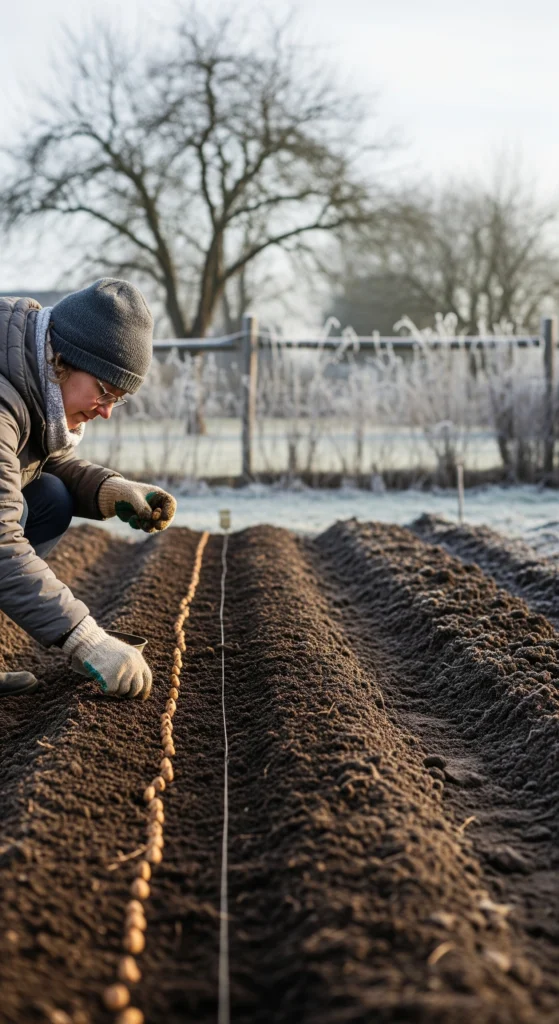
Troubleshooting Common Winter Growing Challenges
Growing beets in winter isn’t always smooth sailing. Cold temps, short days, and wet soil bring their own drama.
Here’s how to handle the usual troublemakers.
Poor germination
Cold, soggy soil makes seeds lazy. They either sprout super slow or not at all.
Fix it:
- Warm the soil with row covers or black plastic
- Improve drainage (raised beds help)
- Soak seeds before planting
- Pick cold-hardy varieties made for winter
Slow growth
Your beets aren’t broken—they’re just cold. Less sun and lower temps = slower growing. Totally normal.
Fix it:
Chill. Keep the care consistent. Don’t dump extra fertilizer thinking it’ll speed things up—it won’t.
Root splitting
Soil goes dry, then wet? Your beets will freak out and split open.
Fix it:
Mulch to keep moisture steady. Water when needed, not randomly. Don’t let the soil swing between desert and swamp.
Premature bolting
Sudden cold followed by a warm-up can make beets panic and flower early.
Fix it:
Use bolt-resistant varieties. Keep temps steady with row covers. Once they bolt, that root’s done—so prevention is key.
Storage rot
Handle beets rough at harvest and toss them in a damp, stuffy spot? Hello, rot city.
Fix it:
Harvest gently. Store in a cool, dark place with good airflow and just the right humidity—think fridge drawer, not swamp cave.
How to Win at Winter Beets (Without Losing Your Chill)
Growing beets in winter takes planning, patience, and the right variety—but it totally pays off.
Pick cold-hardy types, prep your soil, and space out your plantings so you’re not harvesting everything at once.
Growth will be slow (it’s winter, after all), but the flavor? Sweeter than summer.
Seriously, cold-grown beets taste way better than store stuff.
Start small. Try containers if space is tight. Learn as you go.
Winter beet growing is a solid move if you want fresh, homegrown food when most gardens are sleeping.

